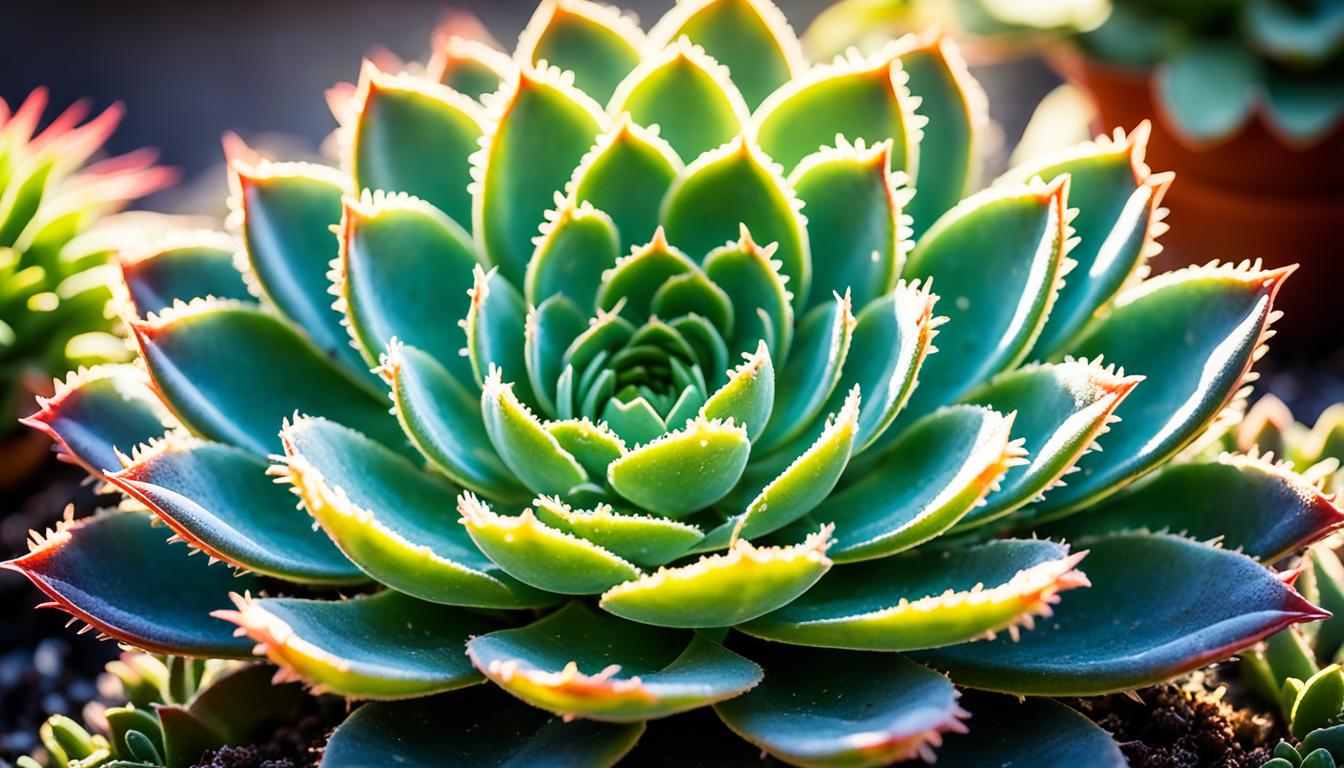Did you know that the Hen and Chicks Succulent is super popular? It’s perfect for small spaces because of its size and toughness. This guide is great for anyone wanting to grow these plants indoors.
Key Takeaways:
- Learn how to care for and grow the Hen and Chicks Succulent in your apartment.
- Discover why this succulent is loved by many for its air-purifying capabilities and pet-friendly nature.
- Understand the ideal light, water, and fertilizer requirements for this plant.
- Explore different potting and propagation methods to help your succulent thrive.
- Find out how to deal with pests and diseases and maintain the long-term health of your plants.
Why Do We Love the Hen and Chicks Succulent For Apartments?
Many people in apartments love the Hen and Chicks Succulent. It has a special charm and lots of perks. It looks good and is great for living in small places.
Is the Hen and Chicks Succulent Air-Purifying?
The Hen and Chicks Succulent cleans the air. It takes out bad stuff and makes the air better. At night, it gives off oxygen. This makes it perfect for bedrooms or living areas.
Is the Hen and Chicks Succulent Pet Friendly?
If you have pets, this succulent is safe. It’s not harmful to cats, dogs, or other pets. You can have it in your home and not worry about your pets.
How Big Does the Hen and Chicks Succulent Get?
This succulent’s size can change with its type and how it grows. But, it usually stays small. This makes it great for small apartments.
The “hen” gets a few inches big. The “chicks” can be about an inch big. This means it can easily fit on shelves or windowsills.
Want a plant that’s easy to care for and looks lovely? The Hen and Chicks Succulent is a great pick. It cleans the air, is safe for pets, and doesn’t need much space.
How to Grow a Hen and Chicks Succulent – Learn to Grow this Indoor Beauty
Growing a Hen and Chicks Succulent inside is easy if you know what it needs. I’ll guide you through the process to make your plant thrive. We’ll talk about the right pot, soil, light, water, and more.
Choosing the Right Pot and Soil
Choose a pot with good drainage for your Hen and Chicks. It should be shallow with holes at the bottom.
Hens and Chicks like sandy soil that drains well. You can use a mix made for cacti, or mix potting soil with sand.
Providing Adequate Light
Put your plant where it gets a lot of light. It should get 4-6 hours of sun each day. Use a grow light if you don’t have enough sun.
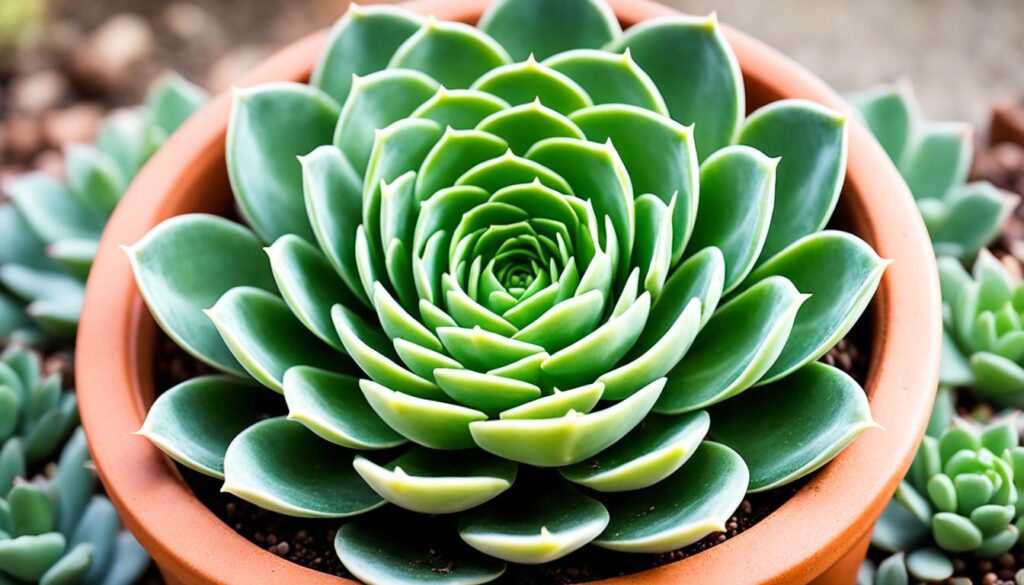
Watering and Humidity
This plant doesn’t need much water. Let the soil dry before watering again. Water well, but make sure all extra water drains.
Hens and Chicks don’t need much humidity. They are perfect for indoors.
Nutrition and Fertilization
They don’t need much food. Fertilize lightly with a half-strength solution during growing season. Do this every few months.
Pruning and Maintenance
Cut off any bad leaves to help new ones grow. Use sharp scissors and cut near the plant’s base.
Looking after your plant is simple. Check it often for pests or other problems. Take off dead leaves to keep it looking good.
Propagation
You can get more plants through propagation. Use offsets, leaves, or stem cuttings. Pick the method you like best.
Monitoring for Pests and Diseases
Even easy plants like these can get pests. Look for bugs like mealybugs or aphids. Treat them quickly if you find any.
Following these tips will help your Hen and Chicks do well inside. Good care leads to a healthy, beautiful plant.
Appearance of Hen and Chicks Succulent
The Hen and Chicks Succulent has a unique look. Its special traits make it loved by those who enjoy succulents. Now, let’s see what makes this plant so interesting.
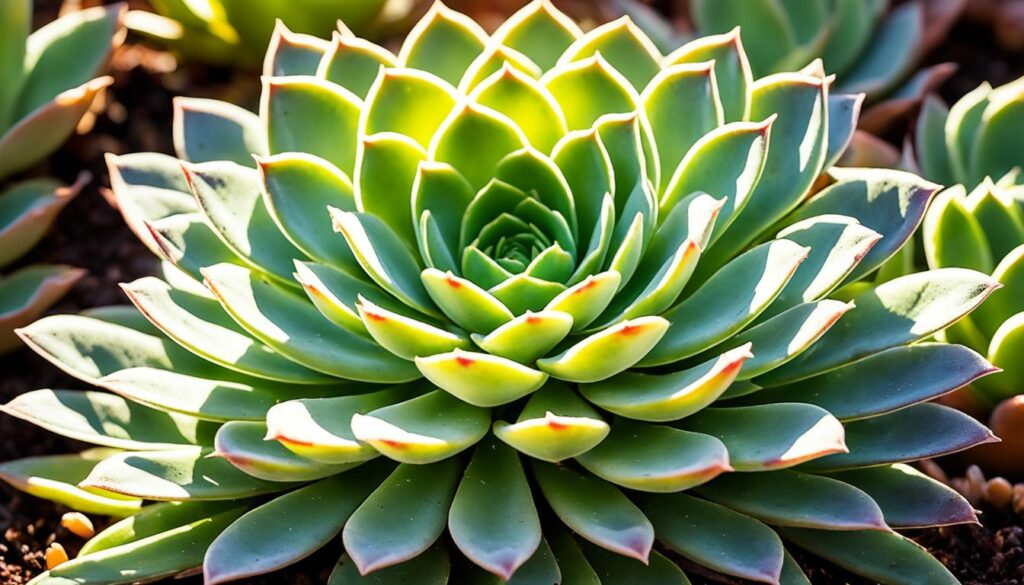
This plant forms rosette-shaped leaves in a tight circle. It looks like a lovely bouquet. The leaves are thick and come in many colors. You can see vibrant greens, reds, purples, and blue-gray. These colors brighten up any room.
As it grows, the Hen and Chicks makes “chicks.” These chicks grow near the main plant. They make the plant look like a cluster. That’s why it’s called “Hen and Chicks.” It looks really pretty.
Do you like the green ones or the colorful ones better? Either way, this plant will look great in your place. It adds beauty and starts fun talks about plants.
Now, we know how the Hen and Chicks Succulent looks. Next, we’ll find out how much light it needs.
Light Requirements for Hen and Chicks Succulent
Every plant needs light to grow, and the Hen and Chicks Succulent is no exception. To keep it healthy indoors, it’s crucial to know how much light it needs.
Hen and Chicks Succulent loves bright, but not direct, sunlight. A spot near a window that gets filtered light is perfect. But, direct sun is a no-go as it can hurt the plant. If you don’t have enough sun, artificial lights can help too.
This succulent needs a good amount of light―not too little, not too much. Not enough light will make it stretch. Too much can burn its leaves. Finding the right light mix is key for its health.
It should get 6-8 hours of indirect light daily. Each Hen and Chicks Succulent might need slightly different light. Watch your plant and see what works best.
Good light is vital for your Hen and Chicks Succulent to look and feel great. With the right light, your plant will thrive and brighten your room.
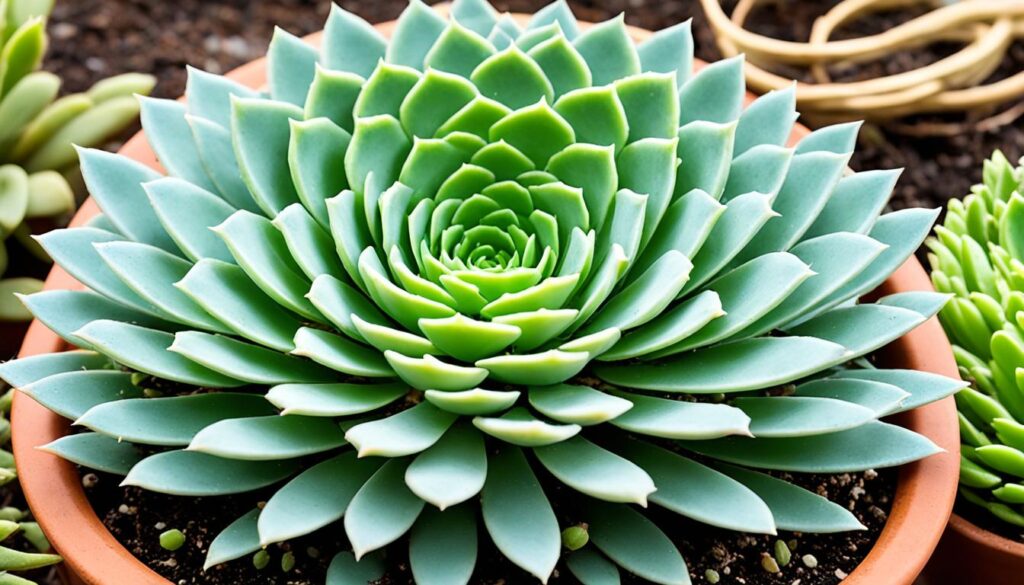
Watering Requirements of the Hen and Chicks Succulent
Proper watering is very important. It keeps the Hen and Chicks Succulent healthy.
This plant can live with very little water. But it needs the right amount.
When deciding how much to water, think about these things:
- Soil Moisture: This plant likes dry soil. Put your finger in the soil to check. If dry, it’s time to water.
- Frequency: Water when the soil is dry. This keeps the roots healthy and not too wet.
- Watering Method: Use a tray of water and let the plant drink from the bottom. This helps roots grow strong.
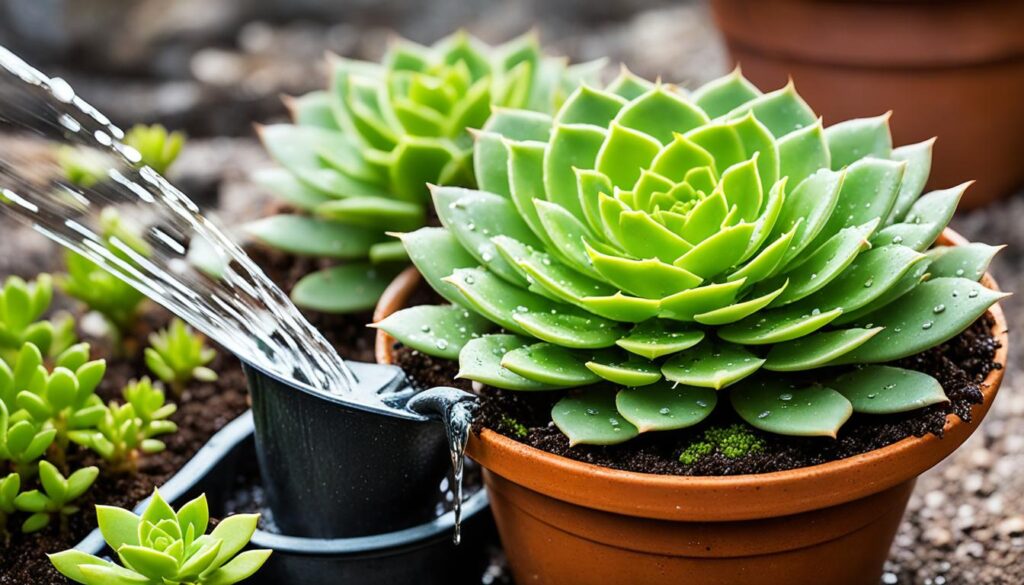
Signs of Overwatering vs. Underwatering:
Too much water can hurt your plant. Look for these bad signs:
- Yellow or brown leaves
- Stems that are mushy
- Plant looks sad
- Soil smells bad
Not enough water makes the plant dry. Watch for these signs:
- Leaves look wrinkled
- Color is pale
- Leaves fall off
- Growth slows down
Keep an eye on these signs. Change your watering to keep the plant happy.
Fertilizing a Hen and Chicks Succulent
Fertilizing your Hen and Chicks Succulent is key. The right food makes them grow strong and vibrant.
Be sure to pick the best fertilizer for good results.
Recommended Fertilizer for a Hen and Chicks Succulent
Use a balanced, water-soluble food for your Hen and Chicks. Choose one made for cacti and succulents.
These special foods have what these plants need.
Succulent Plant Food is great for Hen and Chicks. It has nitrogen, phosphorus, potassium, iron, and manganese.
It’s made just for succulents, including Hen and Chicks.
How to use Succulent Plant Food:
- Mix the food as the package says.
- Put the mixed food in the soil near your plant.
- Then, water your plant well so the food spreads in the soil.
But remember, using less food is better for Hen and Chicks. They don’t need much.
Too much food can hurt your plant.
Feed your Hen and Chicks in spring and summer. This helps them grow.
In fall and winter, they don’t need food.
Always read and follow the food label. Watch how your plant responds.
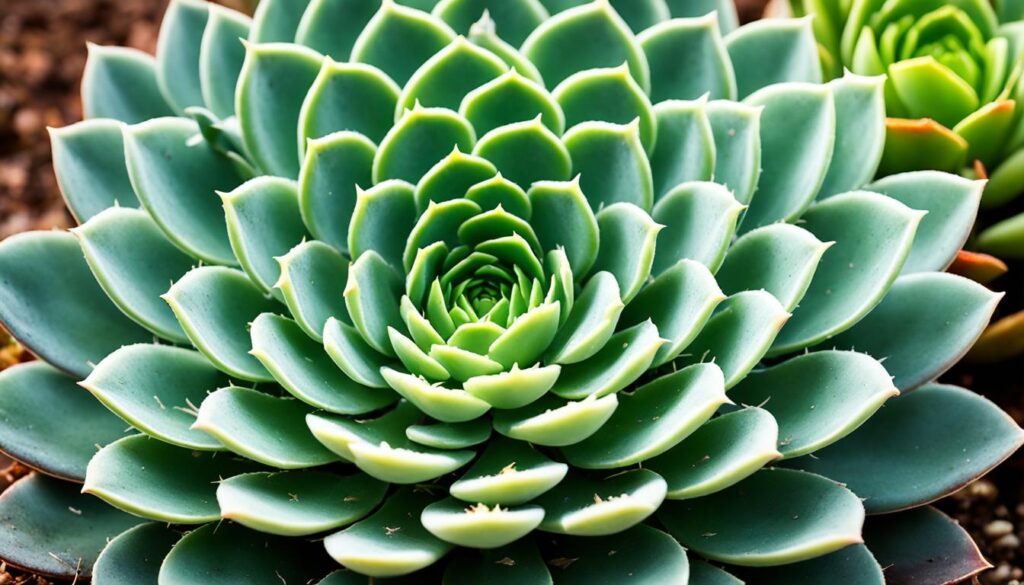
Potting a Hen and Chicks Succulent
Proper potting helps a Hen and Chicks Succulent grow well. You’ll learn how to choose the right pot, use the best soil, and repot when needed here.
Choosing the Right Pot Size
A Hen and Chicks Succulent needs space to grow. This is because they make new plants, called “chicks”, around their main part.
For small or young plants, a 4-inch pot is good. But for big plants or those with many chicks, a 6 or 8-inch pot is better. This gives them room without crowding.
Using the Right Potting Mix for a Hen and Chicks Succulent
The right soil mix is key for a Hen and Chicks Succulent. They need soil that drains water fast. This stops root rot.
To make a good mix, use potting soil, sand, and perlite in equal parts. This mix holds moisture well but also drains well.
Or, buy a ready-made mix for succulents and cacti. It’s made just for plants like Hen and Chicks Succulents.
Repotting When Necessary
Sometimes, a Hen and Chicks Succulent outgrows its pot. This can lead to too little space and not enough food. Also, the plant might not grow as big as it could.
To keep your plant healthy, repot it when it’s too big. You might see roots packed tight or water not soaking into the soil. Or the plant could tip over because it’s too top-heavy.
When repotting, take the plant out gently. Loosen the roots if needed, and put it in a new pot. Use new soil. Be gentle with the leaves and roots.
The aim of repotting is to give your Hen and Chicks Succulent room to grow well.
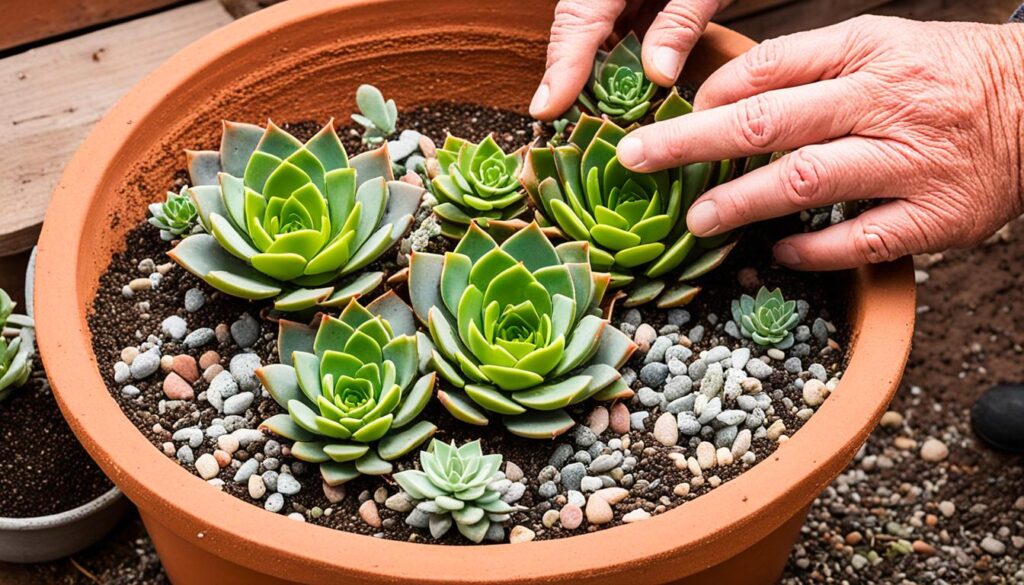
Propagating a Hen and Chicks Succulent
Propagation lets you make new Hen and Chicks Succulent plants. You can try different methods to grow your collection.
Stem Cuttings Or Seeds?
You can use stem cuttings or seeds to grow a Hen and Chicks Succulent. Both ways are good and can work well.
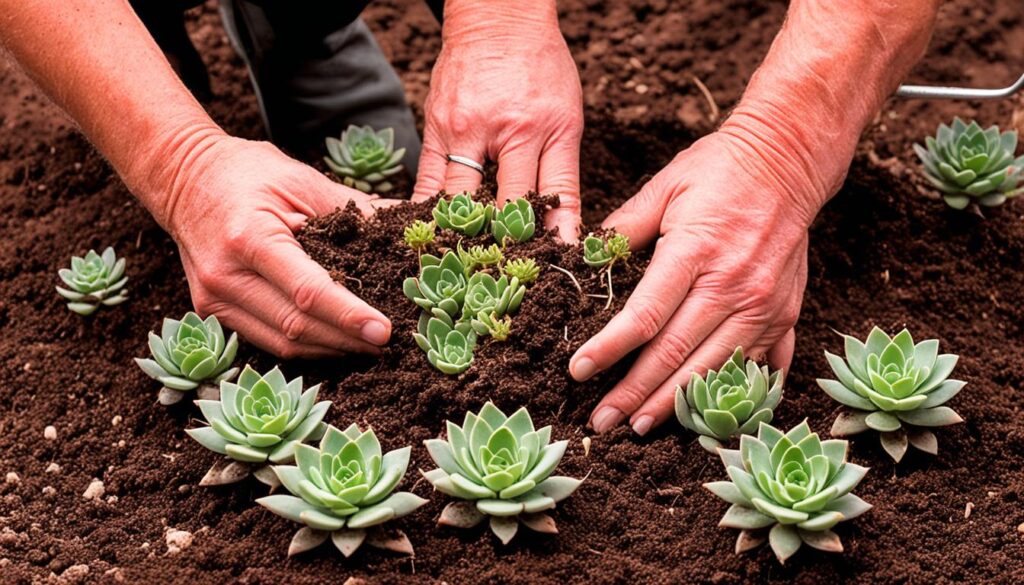
Stem Cuttings: A common way to grow these plants is through stem cuttings. Just cut a healthy stem and let it grow roots.
Seeds: It’s fun to grow Hen and Chicks Succulent from seeds. You get to see the plant grow from the start.
Division Of A Hen and Chicks Succulent
You can also grow Hen and Chicks Succulent by division. This means you take the little “chicks” from the main plant and plant them.
This is a good way to make old plants young again. Or to give some plants to friends.
Growing Hen and Chicks Succulent through cuttings, seeds, or division is rewarding. It’s a great way to add more plants to your collection.
Growth and Development of the Hen and Chicks Succulent
It’s key to know how the Hen and Chicks Succulent grows. This knowledge helps in taking good care of it.
The plant starts growing from seeds or offsets. At first, it makes small rosettes with some leaves. Hen and Chicks spread fast by making many offsets near the main plant.
Then, it grows more leaves and bigger rosettes. This time is important for its roots and shape.
Next, it becomes an adult plant. The rosettes get big, colorful, and strong. It can now handle different weather.
Many things affect its growth rate. Light, water, and the right soil are important. So are nutrients, temperature, and humidity.
Knowing about this plant’s growth helps it stay healthy. This way, your succulent will always look beautiful.
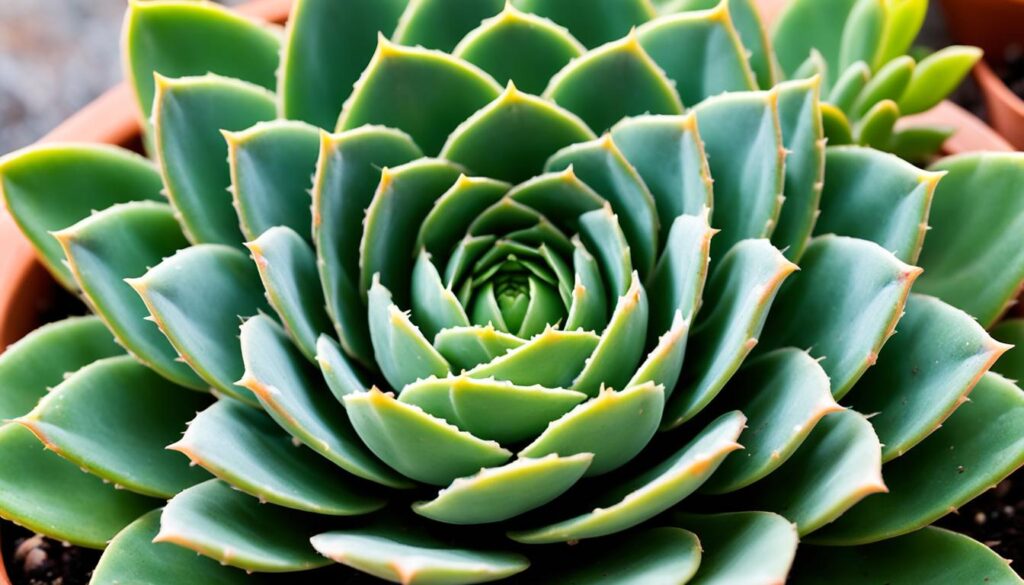
Dealing with Pests and Diseases in the Hen and Chicks Succulent
Learn how to fight pests and diseases in Hen and Chicks Succulent here. These succulents might get sick or have bugs. We’ll show you what problems they face and how to fix them.
Pests
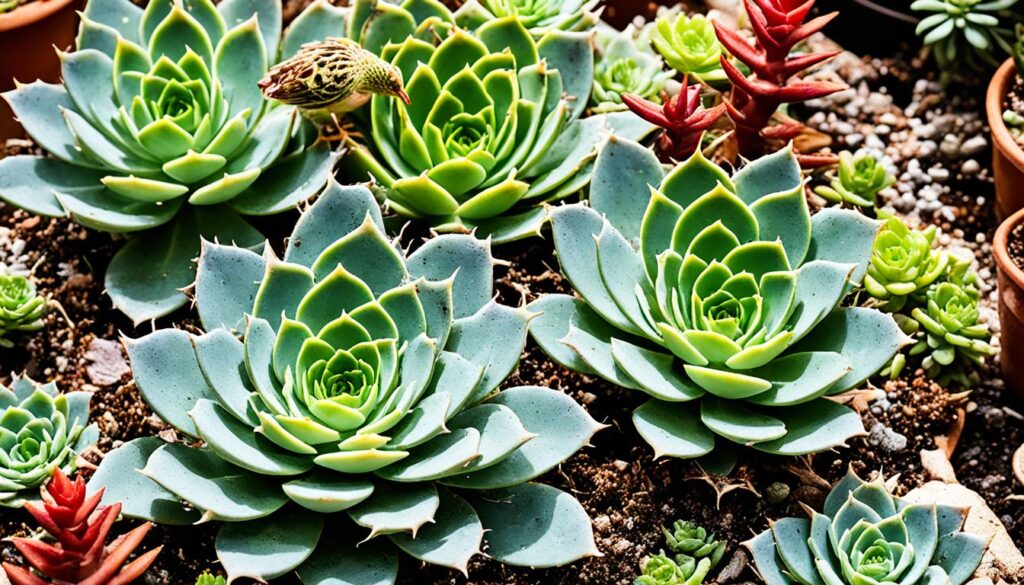
Pests can hurt your Hen and Chicks Succulent. They may stop it from growing well. Here are some bugs you might see:
- Mealybugs
- Aphids
- Spider mites
It’s hard to see these pests, but they can damage a lot. Check your plants often for any bugs.
Diseases
Succulents are usually strong but can get sick. Here are some diseases that Hen and Chicks can get:
- Root rot
- Fungal infections
Too much water or bad drainage causes these problems. Make sure your plant is not too wet to stay healthy.
Prevention and Control
Stopping pests and diseases is easier than fixing them later. Keep your Hen and Chicks Succulent safe by:
- Checking your plants for problems regularly.
- Keeping sick plants away from healthy ones.
- Using good bugs to fight bad ones.
- For big problems, you might need chemicals. Ask a pro what to use.
Stay ahead of problems to keep your succulent looking great. Enjoy these pretty plants without worry.
Common Hen and Chicks Succulent Pests
To keep your Hen and Chicks Succulent healthy, watch for pests. Spotting them early lets you protect your plant. Here are some pests to look out for:
1. Mealybugs: Mealybugs are tiny bugs that suck plant sap. They look white because of a waxy cover. They can stunt growth and make leaves yellow.
2. Aphids: Aphids are small and suck sap from the plant. They can be many colors. They breed fast, causing leaves to curl and viruses to spread.
3. Spider mites: Spider mites are so small, it’s hard to see them. They damage leaves and thrive in dry heat, which is bad for the plant.
Check your plant often for pests. Look for bugs, sticky leaves, or unusual changes. This helps keep it healthy.
If pests show up, you can fight them in several ways. You can clean leaves with soapy water or use neem oil. You might also try bringing in helpful bugs like ladybugs. For big problems, there are special bug-killing chemicals. Just be sure to use them right.
Natural Predators
Natural predators and diseases can keep your Hen and Chicks Succulent healthy. Ladybugs, lacewings, or predatory mites can stop pest problems. This way, you avoid harmful chemicals.
Isolate Infected Plants
See pests or diseases on your succulents? Act fast to stop them from spreading. Isolate the sick plants from healthy ones. This lowers the risk of the whole collection getting sick.
Chemical Treatment
Sometimes, natural fixes aren’t enough. Then, you might need chemical treatments. Be careful and follow the directions when using insecticides or fungicides. Choose one safe for succulents. Remember, plant health and safety first.
Disease Prevention For Hen and Chicks Succulents
Keep your Hen and Chicks Succulents healthy by preventing diseases. Proper care and prevention are key.
Follow these tips to avoid common diseases in Hen and Chicks Succulents:
- Water properly: To avoid root rot, water your succulents just enough. Let the soil dry before watering again.
- Use well-draining soil and pots with holes. This helps keep roots dry and healthy.
- Give them space: Plants need room to breathe and stay dry. Crowded plants can get sick easily.
- Watch for disease signs: Look for discoloration or strange shapes. Catching disease early is important.
- If a plant looks sick, keep it away from healthy ones. This stops the disease from spreading.
- Good air flow is crucial: It keeps moisture down and prevents fungus. Don’t let air sit still around plants.
These steps will help your Hen and Chicks Succulents stay disease-free.
Tips for Maintaining Hen and Chicks Succulents
Hen and Chicks Succulents need good care for their health and beauty. These simple tips will help them thrive and brighten your home.
Wiping Leaves
It’s important to clean their leaves regularly. Dust blocks sunlight and stops photosynthesis. Use a soft cloth to wipe the leaves. This will keep them healthy and shiny.
Outdoor Exposure
These succulents like some outdoor time in good weather. Put them in a shady spot outside. But watch the weather! Bring them in if it gets too hot or cold.
Adjusting Watering Schedule
Change how often you water them with the seasons. They need more water in spring and summer. But less in fall and winter. This keeps them just moist enough.
These care tips will help your Hen and Chicks look great for years.
Tips for Successful Overwintering of Hen and Chicks Succulent
Overwintering is key for Hen and Chicks Succulent survival. To make sure they thrive, you must provide the right settings. Here are tips to help:
- Temperature: These succulents are tough in cold but need protection from very cold winters. Keep them in a cool spot, between 45-55°F. Cover them if it gets colder than freezing.
- Light: They still need light to live, even when dormant. Place them somewhere they can get indirect sunlight daily. But, keep them away from direct sun to avoid burns.
- Watering: Water less in winter to stop root rot. Let the soil dry fully before watering again. It’s vital to keep them moist enough but not too wet.
- Humidity: These plants like it not too humid. Use a dehumidifier or keep them near an airy spot if it’s humid inside.
- Protection from frost: Protect them from frost if your area gets frosty. Bring them inside or use a frost cloth or a greenhouse for warmth.
By following these tips, your Hen and Chicks will get through winter well. Check them often and adjust care as needed.
With right care, your Hen and Chicks will keep making your indoor garden lovely for years!
Growing Hen and Chicks Succulent from Seed
Growing Hen and Chicks Succulent from seed is fun. With care and patience, you can see its life cycle from the start. Are you ready to start this journey? Here’s a guide to grow Hen and Chicks Succulent from seeds:
1. Gather Your Supplies:
- Hen and Chicks Succulent seeds
- Well-draining potting mix
- Seed trays or small pots
- Mister or spray bottle
- Clear plastic wrap
- Watering can or spray bottle
2. Prepare Your Potting Mix:
Put a well-draining mix in your trays or pots. This plant likes gritty soil to avoid wet roots.
3. Sow the Seeds:
Spread the seeds on top of the mix. Press them in lightly but don’t cover them up. They need light to grow.
4. Mist the Seeds:
Use a mister to wet the seeds. But keep the soil from getting too wet. It should be moist, not soggy, as they grow.
5. Cover for Germination:
Cover the seeds with plastic wrap to keep them moist and warm. This helps them start growing.
6. Provide Indirect Light:
Put the trays or pots where it’s warm but not in direct sun. Direct sun can hurt the new plants.
7. Monitor and Care for Seedlings:
Check often to keep the soil just right – slightly damp. It might take up to three weeks for the seeds to sprout.
8. Transplanting Seedlings:
When they have a few real leaves, move them to their own pots. Be gentle with the little plants.
9. Gradual Hardening Off:
Start putting the plants outside for a bit each day. Increase the time slowly. This gets them used to the outdoors.
10. Continued Care:
Keep caring for them as you have been. They need good light, water, and food to grow strong.
Varieties of Hen and Chicks Succulent
Hen and Chicks Succulent, or Sempervivum, has many amazing types. They make indoor spaces beautiful and diverse.
The Sempervivum arachnoideum is a cool variety. It has leaves like a rosette. They are covered in white web-like hairs. This makes it look like a spider web. Its interesting hairs catch water well. This makes it a striking plant choice.
If you love bright colors, look at Sempervivum ‘Ruby Heart’. Its leaves become deep red, like rubies. This type makes any plant group or garden stand out.
The Sempervivum tectorum has a gentle yet lovely style. Its pale green leaves have pink to reddish-brown tips. They create a pretty contrast. This variety makes any place look better. The Sempervivum tectorum thrives in various environments, making it a versatile choice for both indoor and outdoor gardening. When combined with lush greens, its unique color palette truly stands out. For those looking to complement their gardening journey, exploring velvet calathea care tips can enhance the overall aesthetic of your plant collection.
Hen and Chicks Succulent has lots of options for nice indoor gardens. You can choose from colorful or gentle looking plants. There’s a type of Hen and Chicks Succulent for everyone’s taste.
FAQ
Q: Why do we love the Hen and Chicks Succulent for apartments?
A: People love it because it cleans the air. It’s safe for pets and grows well inside.
Q: Is the Hen and Chicks Succulent air-purifying?
A: Yes, it cleans the air. This makes it great for inside spaces.
Q: Is the Hen and Chicks Succulent pet-friendly?
A: Yes, it’s safe for pets. But watch your pets around it. Talk to a vet if worried.
Q: How big does the Hen and Chicks Succulent get?
A: It can grow 4-6 inches tall and 6-8 inches wide. This can change with the type and care.
Q: How to grow a Hen and Chicks Succulent – Learn to grow this indoor beauty
A: To grow it inside, you need to take care. Use the right pot and soil. Make sure it gets enough light.
Water it right and keep it humid. Feed it and keep it trimmed. Start new plants and keep pests away.
Q: What pot and soil should I choose for a Hen and Chicks Succulent?
A: Choose a pot with holes for water to drain. Use special soil for succulents.
Q: How much light does a Hen and Chicks Succulent need?
A: It needs bright light but not direct sun for 4-6 hours a day. A south window is good.
Q: How often should I water my Hen and Chicks Succulent?
A: Let the soil dry before watering again. The needs change with the seasons.
Q: What fertilizer should I use for a Hen and Chicks Succulent?
A: Use half-strength liquid or granular food in spring and summer. Don’t feed it in winter.
Q: How do I choose the right pot size for a Hen and Chicks Succulent?
A: Pick a pot just bigger than the plant’s rosette. Too big a pot can harm it.
Q: How can I propagate a Hen and Chicks Succulent?
A: You can start new plants with stem cuttings or by dividing. Seeds work, too. We show how.
Q: What are the different growth stages of a Hen and Chicks Succulent?
A: It grows roots, then a rosette, and then little offsets. This helps you care for it right.
Q: What are common pests and diseases that can affect a Hen and Chicks Succulent?
A: Watch out for mealybugs, aphids, spider mites, root rot, and fungus.
Q: How can I prevent and control pests in a Hen and Chicks Succulent?
A: Keep things clean. Use good bugs to fight bad ones. Isolate sick plants. Sometimes, use chemicals.
Q: How can I prevent diseases in a Hen and Chicks Succulent?
A: Water it right. Keep air moving. Avoid too much water. Clean up and maybe use fungicide.
Q: How should I maintain a Hen and Chicks Succulent?
A: Clean its leaves. Let it go out if the weather’s good. Change how much you water when seasons change.
Q: How can I successfully overwinter a Hen and Chicks Succulent?
A: In winter, keep it cool and dim. Don’t water too much. Watch for trouble. Our tips help.
Q: How do I grow a Hen and Chicks Succulent from seed?
A: Use the right mix and conditions to start seeds. Light and water matter. We guide you.
Q: What are some popular varieties of Hen and Chicks Succulent?
A: There are many types like “Cobweb Buttons,” “Dragon’s Blood,” and “Rubra.” Each is special.

